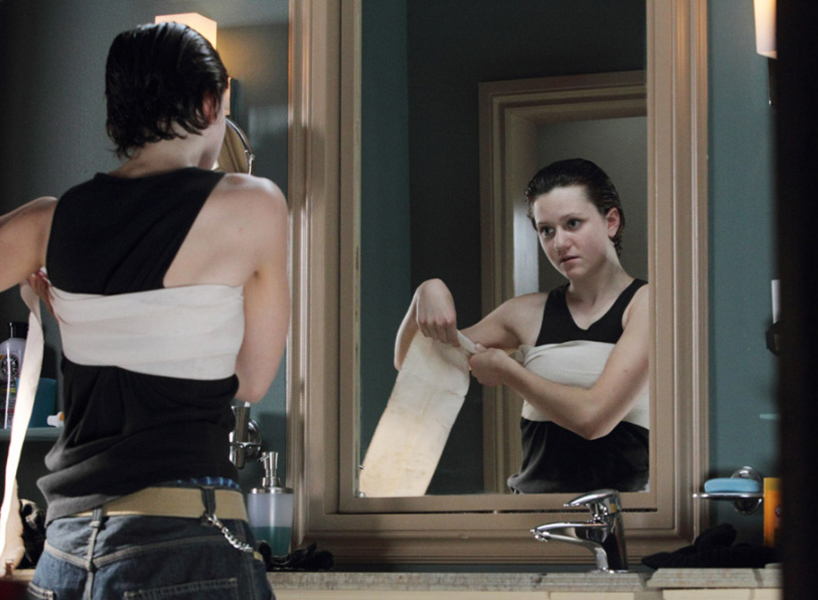“My Breasts Left Me Anxious and Embarrassed”: Chest Binding and How to Do It Safely
For many folks, chest binding can help improve mood and self-esteem. Here's what you need to know about it


For most of my life, my body has been blissfully androgynous. As a short, thin person with very few curves, I’ve had the privilege of not having to think of my body’s shape much at all. Shifting my gender presentation has always felt comfortable for me, and a relatively androgynous body had allowed me to do so fairly easily. As I hit my mid-twenties though, that started to change. I began to hold weight in places I wasn’t used to. My body became softer, rounder. And I hated it.
My chest grew particularly contentious. Any instances in which my breasts felt exposed left me anxious and embarrassed. Triangle bikinis? Impossible. Taking baths? Uncomfortable. Sex? Deeply unappealing.
What I was experiencing was dysphoria, a feeling of discomfort that arises when your body and your gender identity are mismatched. I posted about how I’d been feeling on Instagram, and many of my queer, trans and gender non-conforming friends reached out to commiserate and offer advice. I knew a handful of people who had used chest binders, and after doing some research, I eventually decided to try binding myself. I started off with a form-fitting sports bra, and eventually moved on to wearing a chest-binder some days.
It helped. Binding isn’t a cure-all—I haven’t completely made peace with my chest—but on the days I need it, the practise has allow me to feel more confident and at home in my body.
My experience isn’t unique. A 2016 study published in Culture, Health & Sexuality—the first about chest binding to appear in a medical journal—found that binding improved mood and self-esteem and lowered anxiety, depression and dysphoria for many participants. So if you’re thinking about chest binding, here’s what you need to know.
What is chest binding?
Put simply, people use binders—compression garments that can be shaped like sports bras, crop tops or tanks—to make their chests appear smaller or flatter.
“A lot of people believe that binders are only for trans folks,” says Tate Sameshima, owner of TKVO, a queer gift shop in Toronto that hosts a pay-what-you-can binder program. “But it’s super important to understand that it doesn’t matter how you identify—a lot of people find binders helpful.”
While many trans men who haven’t had top surgery do wear them, non-binary folks, and even cisgender women who want more support or a flatter appearance, also use binders.
For those who have it, “dysphoria is such an overwhelming part of day-to-day life,” says Sameshima. “Chest binding is a small way to alleviate some of the anxiety that we carry around.”
How to find the right chest binder
Binders normally come in two popular shapes: tri-tops, which cover the chest and are about the length of a crop top, and full-length binders, which cover the chest and stomach and can help to lend a more typically masculine shape to those who feel dysphoric about their hips. No one shape is more effective or safe than the other. It’s best to try a variety of styles and see what looks and feels best to you.
A good binder will usually set you back at least $30. Wrapping yourself in elastic medical bandages or using duct tape may seem like a cost-effective alternative, but these options are dangerous. They can damage your skin, and affect your breathing and blood flow, says Sameshima. Play it safe, and find a garment designed specifically to bind.
If cost is a barrier, research organizations in your city or province that provide pre-loved binders for free, or on a pay-what-you-can-basis, like Binders Out in Toronto or Point of Pride, an Oregon-based group that ships donated binders internationally.
Binders may be practical items, but that doesn’t mean they can’t look fun: they come in skin tones, neutral colours, loud patterns and even lacy designs. While materials vary, they’re often made out of thick and durable nylon and spandex. If possible, try a few different shirts with your binder to make sure you like the way the style and fit looks under your clothes. The right binder can lessen your dysphoria and add some self-assurance.
“What I see the most when people try on binders for the first time is that they’re leaving super thrilled,” says Sameshima. “Binding is such a vital piece of being able to go outside and feel confident in your body.”
Don’t forget to measure!
The quickest way to find the right fit is to measure yourself. GC2B, an LGBTQ-owned company that sells chest-binders offers a comprehensive measurement guide.
“People often choose the wrong size out of eagerness,” Sameshima says. Many people trying on a binder for the first time look for the smallest possible fit, hoping to get the most compression, he explains. But wearing a binder that’s too small can be damaging, and can cause the same problems that result from wearing medical bandages or tape.
“You shouldn’t be feeling any real restriction in your breathing,” Sameshima says. “The first time you try a binder will feel a bit confining for sure. But you don’t want to be so uncomfortable that you can’t do physical tasks.” If you can’t comfortably take deep breaths, try the next size up.
While binders will feel a little tight at first, they should stretch out after a few days. If yours is wearing away at your skin, making you feel lightheaded or causing you noticeable pain, it’s time to look for a bigger one.
Folks who wear plus-sizes might have trouble finding binders designed to fit them. Look for companies such as Les Love Boat, which offers sizes up to 5XL, or Shapeshifters, which design custom garments. They can be pricey, but finding the right fit is safer and more comfortable in the long run.
Listen to—and care for—your body
You should avoid wearing your binder for more than eight hours a day, especially if you use it every day. Over time, wearing the garment for long hours can actually break down tissue and cause breathing problems, back pain and skin irritation.
When your binder is full-length, wearing it means you’re also sporting an extra layer of clothing—and that can raise your body temperature. Be mindful of this, especially in the summer. If your binder makes you sweat, stay hydrated. And never bind while working out.
Watch out for physical red flags: whenever you feel itchy, irritated or short of breath, remove your binder and take a break, even if it’s only for an hour or so. And at the end of the day, set aside some time to do deep breathing, slowly filling up your lungs with air.
One evening last month, a friend gave me a binder of hers that had grown too small. The next morning, I picked out my best button up and tried it on. I looked at my reflection head on, then side to side. I jumped up and down, grinning like a big, queer idiot. I ran my hands over my chest, and, finding it flatter, broader started to cry. That thing was tight, but man did I ever feel free.
CORRECTION: June 20: In an earlier Instagram story, FLARE staff identified Tate Sameshima by the wrong name and gender. This error was made while promoting a story about the importance of individuals being able to express and live their true gender identity. Writer Megan Jones had nothing to do with this incident. FLARE deeply regrets this mistake and apologizes unequivocally to Tate Sameshima.








